



|

|

|
On 11th August 1999 a total eclipse of the Sun will be visible from parts of the UK.
It will provide a spectacular display, but why is the Sun so interesting?
To explore Sun Block '99, link through to:
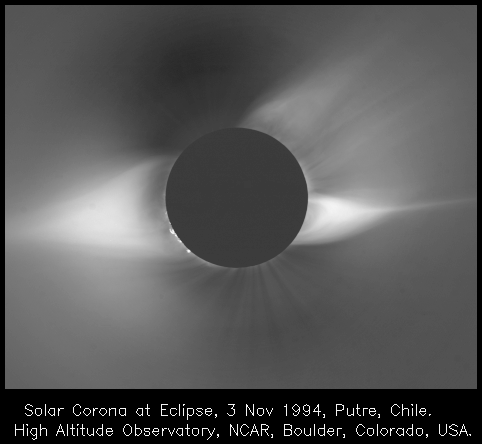
During a total eclipse, the moon completely blocks out the solar disk. What you see is the corona (which means crown), the Sun's outer atmosphere. It's very difficult to see the corona normally because the visible light from the solar surface, the photosphere, is a million times brighter than the light from the corona.
Although the photosphere is a cool 6000 C, the corona is very, very hot - over 1,000,000 C! This problem has puzzled solar physicists for more than 50 years. There are several theories as to why this should be so, none yet fully satisfactory. The corona could be heated by waves travelling up from the photosphere. We know that the magnetic field plays an important role, so magnetic re-connection could transfer magnetic energy into thermal (heat) energy.
If you look at the Sun in X-ray emission you see only the plasma (ionised gas) at above one million degrees. You can clearly see the structure of the magnetic field. The Sun generally has a dipole magnetic field (like a bar magnet). The field lines are open in the polar regions and the corona flows out to form the 'fast' (700 km/s) component of the solar wind. In the equatorial region, the magnetic field is closed and we see bright hot loops of trapped plasma, called active regions. These are locations where sunspots, regions of very strong magnetic field, are seen in visible light. The active regions stretch out into streamers which are the source of the 'slow' (400 km/s!) solar wind.
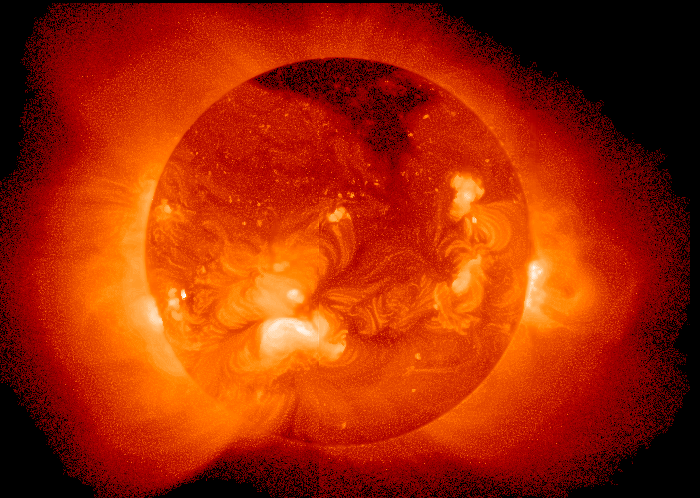
X-ray image from the SXT instrument on YOHKOH, a Japanese satellite (ISAS/NASA/UK).

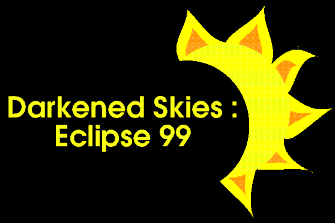
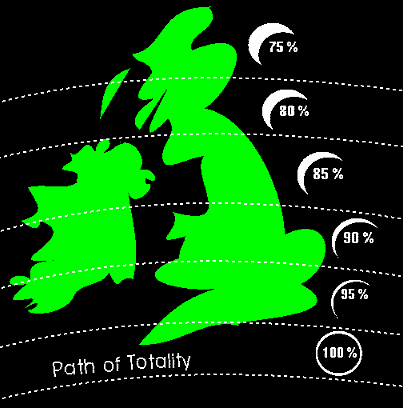
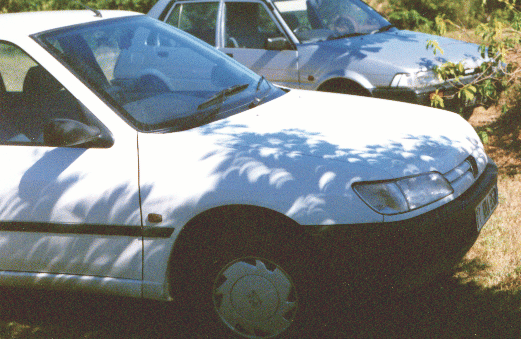
During the first moments of the eclipse, the Moon begins to blockout the Sun's disc. It looks as if a 'bite' has been taken from the edge of the Sun. This photo was taken during the 1998 eclipse in Guadeloupe. You can see many images of the crescent Sun. The gaps in the tree's foliage act like tiny pinhole cameras. Each one focusses an image of the Sun onto the car.

These pictures show what are called BAILY'S BEADS at the end of a total eclipse of the Sun. Baily's Beads are actually caused by rays of light from the Sun's surface, photosphere, shining along crevices on the edge of the Moon.
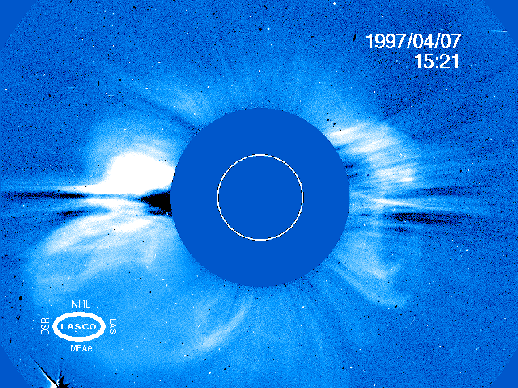
This is an image taken by the LASCO coronagraph on SOHO, which simulates a total eclipse of the Sun. The white circle shows where the Sun's disk should be (if it were not blocked out). Plasma, called a coronal mass ejection, is shot out into the solar wind and can impact on the terrestial environment, causing problems with satellites, radio blackouts and disruption to electricity supplies. This is what we call space weather.
Seismology is the study of earthquakes and is done by measuring the vibrations of the Earth's surface. Helioseismology is a comparatively new field of solar physics (begun in the 1970s) whereby vibrations of the Sun's surface are measured (Helios is the Greek word for Sun).
The vibrations arise through the presence of standing waves in the Sun's interior. In the Sun, we get 3-dimensional standing waves. The solar oscillations near the surface are called P-modes. Here is a picture courtesy of the solar center at Stanford which shows some calculations of the patterns formed by different P-modes on the solar surface. The blue and red patterns show where the amplitude of the waves on the surface are largest (moving in opposite directions). The background yellow is where the surface isn't moving (nodes).

The waves cause the surface of the Sun to move up and down by small amounts, a fraction of one km/s. We can detect these small motions by looking at the Doppler shift in spectral lines emitted by atoms in the solar surface. These movements can be compared to how the Sun is expected to behave from standard theoretical models.
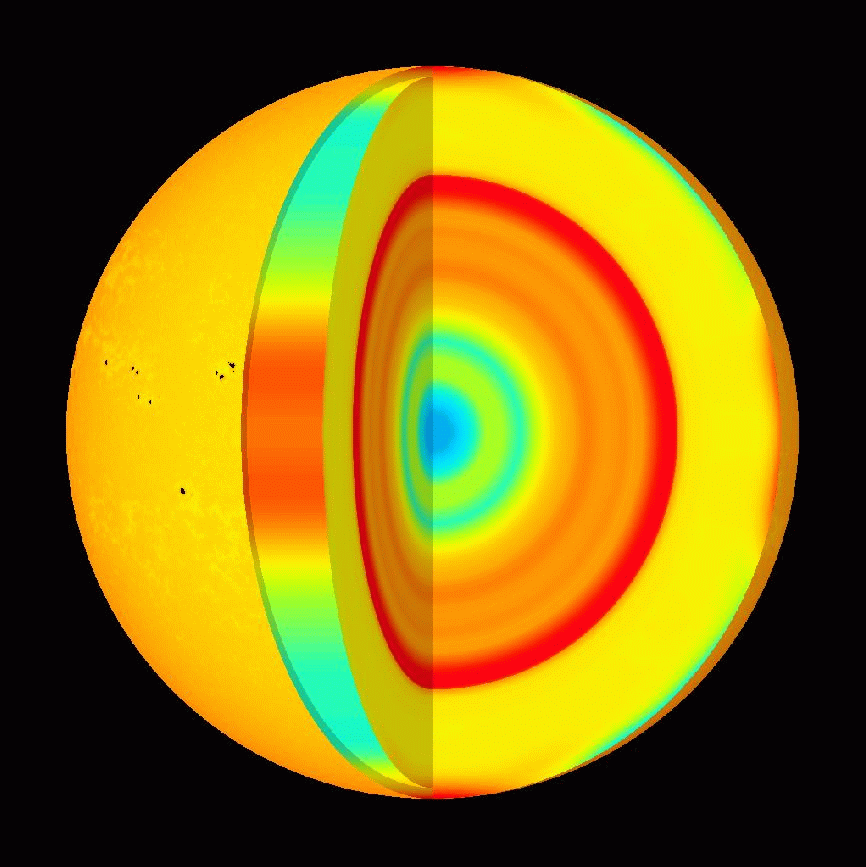
This image was produced from observations by Michelson Doppler Imager (MDI) instrument on the SOHO satellite. It shows the difference between the calculated and predicted speed of sound waves, inside the Sun. In red coloured layers, sound travels faster than predicted by theories. The blue colour means that sound travels slower than expected.
The red layer at about one third of the way down from the surface to the centre of the Sun is thought to be a shear layer just below the solar convection zone. It seems that there may be a lot more turbulence there than predicted. The blue layers in the core of the Sun, indicates that the temperature may be 0.1% cooler than the expected 15 million degrees C. Although this may seem a very small difference, it suggests that the power produced by nuclear fusion may be lower than expected, in fact that it may vary over long time periods.